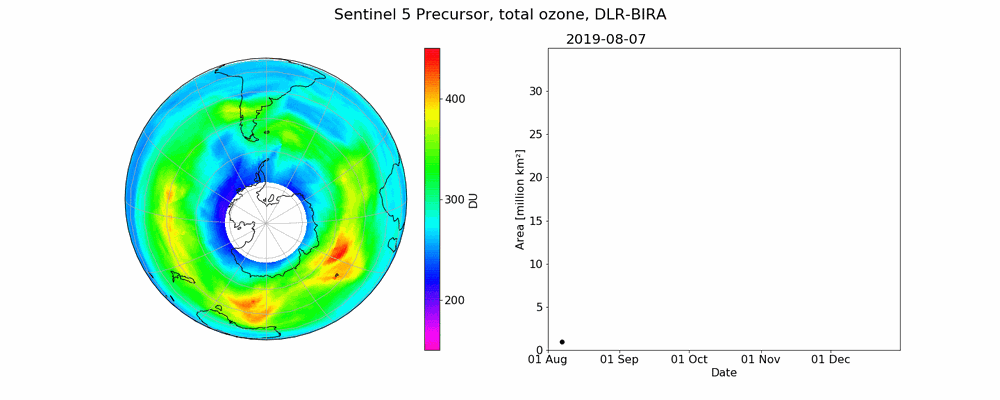The 2019 ozone hole – a sign of recovery?
September 16 is International Day for the Preservation of the Ozone Layer, an occasion to take a look at its present condition. Although chlorofluorocarbons have been internationally prohibited since the Montreal Protocol was signed in 1987, the chemical compounds remaining in the stratospheric ozone layer continue to break down ozone. However, the ozone hole that forms each year over the Antarctic is surprisingly small in 2019.
The Antarctic ozone hole forms within the polar vortex. The low temperatures of minus 80 degrees prevailing there in September and October aid the chemical breakdown of ozone in the stratosphere. Chlorine and bromine compounds that reach the stratosphere in the form of chlorofluorocarbons (FCKW) over the course of decades are the main cause. Only after the Antarctic stratosphere warms up again during southern springtime does the polar vortex collapse and ozone-rich air from the north flow to the pole, causing the ozone hole to recede during December.
The 2019 ozone hole
The ozone hole (the area with an ozone concentration under 220 Dobson units) usually achieves its maximal expansion between mid-September and early October. This year it covered ca. 10 million cubic kilometres; an area almost as large as the USA (~12 millionen km²), big enough, but unusually small compared with previous years. In 2018 the ozone hole was more than twice as large at ca. 24 million cubic kilometres.
Global ozone concentrations are measured daily with the TROPOMI instrument on Europe's Sentinel-5P satellite and also with GOME-2 instruments on METOP-A weather satellites. The latter have provided reference measurements since 2007.
Data from TROPOMI and GOME-2 are analysed at EOC on behalf of ESA and EUMETSAT.
The video shows the size of the 2019 ozone hole over time, based on daily Sentinel-5P measurements. Since the sun is low in the sky during polar winter no measurements are possible for the central area.
The modest size of this year's ozone hole is not a sign of the recovery of the ozone layer. This is because the large fluctuations in solar vortices and temperatures in the stratosphere lead to ozone holes that vary in prominence. Accordingly, small ozone holes are repeatedly observed. This year the polar vortex shifted noticeably toward South America, resulting in relatively mild temperatures of around 40°C below zero in the stratosphere.
Significant recovery of the ozone layer cannot be expected before 2060.

